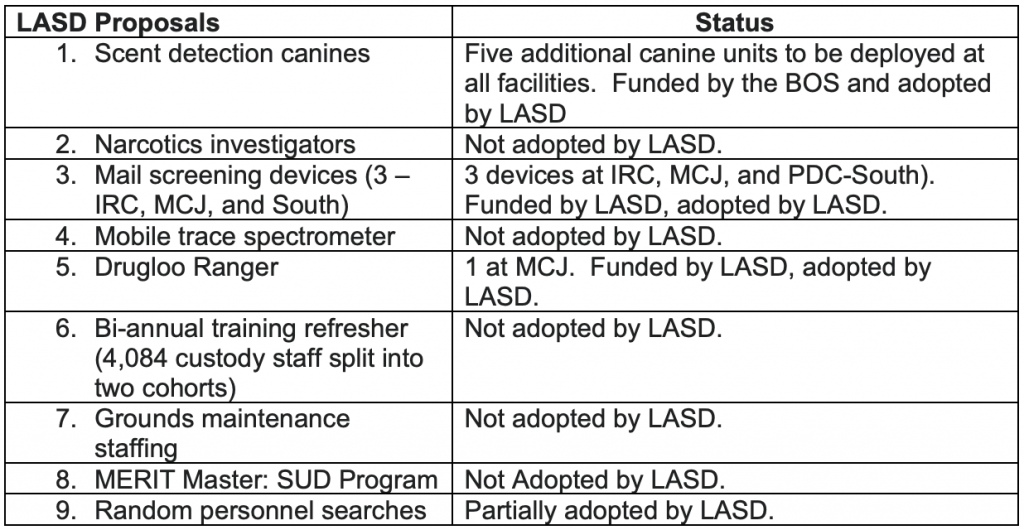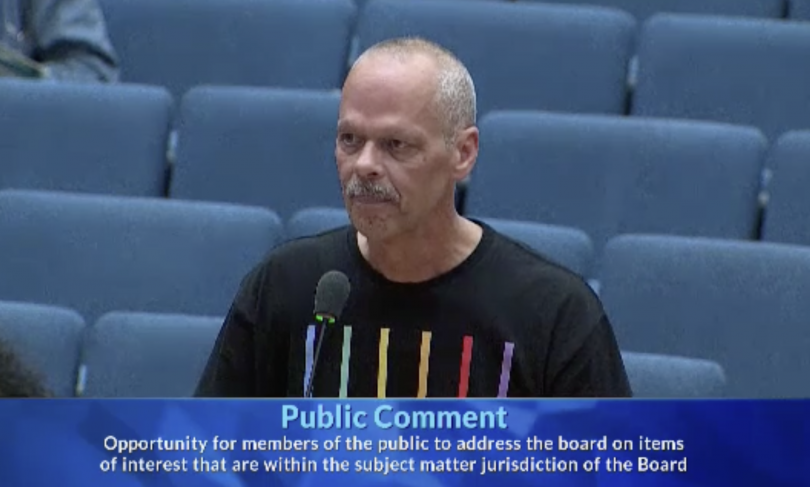On Tuesday, December 19, the Los Angeles County Board of Supervisors approved a motion aimed at reducing overdose deaths in LA County jails.
In their motion, Supervisors Hilda Solis and Janice Hahn note that each year between 2018 and 2022, an average of 37.8 people died in the jails. Approximately 20 percent of those people died due to an overdose, according to the coroner’s office.
At least 46 people have died in LA County jails in 2023, so far.*
Nine people on the LASD’s site are listed as having died due to drugs. The causes of two deaths could not be determined, and autopsy reports are pending for seven other people.
Tuesday’s motion points out that the board has already been combatting overdose deaths by making Narcan — and training for the overdose reversal drug — available to jail staff and incarcerated individuals.
In 2022, the supervisors also called for a report back with recommendations for preventing drugs from entering the jails, patrol stations, and court holding cells. The LA County CEO, LASD, Office of the Inspector General (OIG), Sheriff Civilian Oversight Commission (COC), and the Department of Public Health’s Substance Abuse Prevention and Control came back with ten recommendations, four of which have been fully adopted, and one of which has been partially adopted.

Among the fully adopted recommendations was the LASD’s top priority (and the OIG and COC’s third priority), increasing the LASD’s number of scent detection canines from five to fifteen, with a one-time cost of over $1.2 million, and an ongoing cost of just under $2.5 million.
The department has also adopted recommendations to buy and use three new mail screening devices, a human waste drug tester, and updated body scanners. Recommendations to hire narcotics investigators and grounds maintenance staff, adopt biannual training refreshers, and to use a mobile trace spectrometer have not been adopted.
The Office of the Inspector General and Civilian Oversight Commission had different priorities than the sheriff’s department and, while it was not among the ten recommendations, made it clear that their top priority was to address overcrowding in the jails which “exacerbates problems with drugs being present in the jails.”
The recommendation to conduct random personnel searches, the duo’s second priority (and the sheriff’s department’s ninth priority), has been “partially adopted.”
Yet numerous investigations and news reports show that custody staff continue to bring drugs into prisons and jails nationwide.
Although the LA County Sheriff’s Department “conducts searches on people who are incarcerated, the failures and gaps lie in the lack of comprehensive and consistent searches of custody staff and civilians who work inside the County jails,” Solis and Hahn wrote. While the department implemented a clear bag policy for staff, “the searches need to be thorough and other belongings also need to be searched, such as lunch bags and outside to-go lunch purchases.”
The motion calls for the sheriff’s department to strengthen search policies and conduct “more comprehensive searches of the belongings of staff and civilians who enter the facility, beyond visual inspections.”
The board also wants the department to collect and report data regarding the recovery of narcotics in the jail to better understand what strategies are and are not working.
“There is either inconsistent data or no data on how often searches occur, what is recovered during the searches, how many people go through the body scanners, and what was recovered during the scans.”
The supervisors are also pushing for “holistic” strategies for the drug problem, including more robust treatment and services for those dealing with substance use issues. Medication-assisted treatment is important, but the county must go farther, must implement or bolster “peer-support, community-based treatment diversion opportunities, and therapeutic and rehabilitative programming,” according to the motion. To this end, the board called for a report back on feasibility and an implementation plan.
In a letter to the board, Michelle Parris, Program Director of the California branch of the Vera Institute of Justice, argued that the motion falls short of the county’s “care first, jails last” vision, and urged the supervisors to hold the motion until January, to allow for further changes.
“Much of the proposed motion looks inside the jails when it should instead prioritize decarceration and an increase in funding to the kinds of community-based services that prevent overdose upon release, provide access to care, and are necessary for the success of the motion’s call for coordinating reentry,” Parris wrote. “The Board should prioritize releasing people with drug dependencies to community care programs rather than anchoring the county’s response to drug use in the jail system.” Parris noted that offering peer programs and Medication Assisted Treatment in jails in important, but stressed that “research shows that incarceration is associated with increased risk of overdose death, limited access to harm reduction and treatment services, and disruptions in health care and social support during and after periods of incarceration.”
The county’s top priority, Parris said, should be holding the sheriff’s department accountable, rather than placing increased burdens on incarcerated people and their families.
Many of those who voiced their support for the motion, either in person or by submitting written comments, were formerly incarcerated and saw the deadly effects of drug use in jails and prisons first-hand.
Jack McFadden, a peer support specialist with The Prison Way, described seeing “men be taken out on stretchers that never come back.” Others do come back, he said, “with shame and sorrow on their faces,” but “go right to the same drugs over and over again.” Treatment is critical, McFadden said. “What I want to do is make sure that everybody understands these are people and not just numbers.”
While LA County’s in-custody death tracker puts the count at 45, we know of at least one family speaking out about the fact that the death of their loved one is not included on the sheriff department’s public list. Stanley Wilson Jr., a 40-year-old former professional football player for the Detroit Lions, died on February 1, 2023, while being transported from jail to the hospital, according to the sheriff’s department. Wilson’s mother and sister continue to publicly question the conflicting information they’ve received about the circumstances of their son and brother’s death.


With decriminalization being the governor’s and sadly district attorney’s top priority. This, along with zero bail are a one-two punch in ensuring only the most serious offenders are incarcerated while awaiting trial and/or sentencing. With Narcan being carried by custody staff, and readily available throughout the custody facilities; what more do you want/expect from those working there?
Morale is at an all-time low with the current sheriff at the helm, defunding is still the flavor of the millennia for those who have a strong opinion, yet never did the job. Let’s be honest here, Ms. Walker… LASD has been crapped on since 2009… almost 15 years. It all started when the FBI investigated surfaced, and it hasn’t stopped since.
Through countless investigations, and ongoing oversight… the number of people willing to continue carrying the torch is dwindling. This department used to be one that set the standard… not anymore. For 15 years, the quiet majority has sat idly by while a select few progressives vouch for career criminals boasting sky high recidivism rates.
Now, deputies are reprimanded for being proactive… soon to be groomed to look the other way. We might as well turn in our tan and green for navy blue, and lose the patches too. Progressives turned the county jail into a bed and breakfast for criminals… a safe haven for drug experimentation. Now you want to chastise LASD for the way they’re handling the mess you have made?
I would say shame on you… but you’d just deflect.